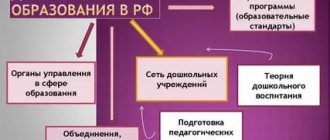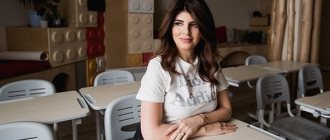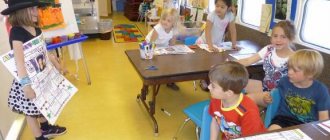What is the national-regional component in OOD?
Let's think logically together. To do this, let’s figure out what the national-regional component is in the process of OOD - organized educational activities.
So, modern educational programs necessarily include a regional component in the process of training, development and education to implement the principle of integrity and integration of preschool education, taking into account the ethnocultural, climatic, geographical, and historical characteristics of a particular region. And this component is implemented through the various activities of children in preschool educational institutions.
The regional component consists of three areas: the study of the ethnoculture of one’s region, the second national language and the history of the region.
Let's consider the types of activities through which the national component is implemented:
- Game activities – thematic national role-playing games;
- Visual activities - modeling, drawing, appliqué with national motifs and introductory conversations on relevant topics;
- Physical culture – outdoor folk games;
- Special events: holidays, matinees, celebrations with a national twist;
- Cognitive activities: excursions, visiting museums, folk art exhibitions;
- Educational and developmental activities - conversations, reading fiction on the history, culture, language of the region, finger folk games, nursery rhymes, poetry;
- Musical classes - learning folk songs, dances, familiarization with ethno-instruments.
It follows from this that the regional component is not carried out as a separate type of joint activity between the teacher and preschoolers, but as a permanent element of the educational process. Let’s say sculpting a national toy, drawing a towel pattern, appliquing a folk jug - this is the implementation of the national component.
And before the lesson, we have an introductory conversation in which we introduce the children to some aspect of national culture and history. As for learning a second national language, there are special programs for this. Honestly, I am not very competent in this matter. Perhaps, in addition to daily activities according to the regular program, additional time is allocated for learning the native language.
Regional component in additional education - relevance and prospects (from work experience)
Author: Denisova Olga Leonidovna
Regional component in additional education – relevance and prospects (from work experience)
The Law “On Education” establishes two components of the standard – federal and national-regional.
National-regional component
provides for the possibility of introducing content related to the traditions of the region. It meets the needs and interests of the peoples of our country and allows us to organize classes aimed at studying the natural, sociocultural and economic characteristics of the region, the national (native) language and national literature.
The regional component is an integral part of education. The tasks of the regional component include the formation in each child of a system of knowledge about the uniqueness of their native land, familiarization with the wealth of folk culture, artistic traditions, and familiarization with folk art.
In our institution, the regional component appeared in 2000 and included educational content directly related to national, regional and local socio-cultural factors.
As the head of the children’s association “Faceless Doll”, in the process of practical activities in her educational program “Doll from Grandma’s Chest”, she identified the following points of the regional component that contribute to the formation in children of love not only for the world around them, but also respect for the traditions and way of life of that territory where they live.
-residence in the Krasnovishersky district of Komi-Yazvintsev;
- literary works about the native land
— project activities
Komi-Yazvintsy
There are only two thousand people on the globe who consider themselves Komi-Yazvin Permians. They all live here in the Krasnovishersky district in the villages of Antipina, Parshakova, Vankova and Verkh-Yazva. They are distinguished from the Komi-Permyaks not only by their habitat and faith (they are all Old Believers), but also by their language. This was noticed by the teacher of the native language of the Parshakovsky secondary school, Anna Lazarevna PARSHAKOVA, author of the Komi-Yazva primer. In addition to historical information about the Komi-Yazva people, we talk about traditions and customs, including the Sarchik holiday, a holiday to welcome spring, dedicated to Nikolin's day on May 22, and make a doll The bird, saying “Sarchik has flown in, bringing spring on his tail.”
The works of Vika Korzhimanova, 8 years old Sarchik, Polina Podvintseva Bird Joy took part in the regional talent competition of the Kama region.
Literary creativity about the native land
Many literary works have been written about the Vishera region
History teacher at school No. 4 Igor Vladimirovich Yakovlev is the author of the book “At the Ancient Rocks.” Igor Vladimirovich collected legends and stories about the natural monuments of the Vishera region. After reading the book, the children made panels from salt dough. The work of Anna Novikova, 9 years old, took part in the regional exhibition dedicated to the anniversary of Krasnovishersk and the regional talent competition of the Kama region.
Since 2011, she began to use the project method in her activities. Our projects are educational. They are spelled out in the educational program.
The peculiarity of our educational projects is that these projects are COLLECTIVE, that is, all children of the children's association work on the project at the same time (1st, 2nd and 3rd year of study). The difference is that the degree of complexity of the work being performed increases, and different materials and techniques are used.
In my educational program there are 3 educational projects - “Mother’s Day”, “Christmas”, “Holy Easter”. When creating projects, children not only enrich their knowledge and skills, but also develop artistic taste and creative thinking, because... create decorative items according to their own design. When working on the creative project “Mother’s Day,” children independently study the history of the holiday in Russia, compose small collections of songs and poems about mothers, write essays, draw portraits of their mothers, and make a doll-amulet “Nurse - a symbol of motherhood.” Sergei Meshurov presented at the school conference the result of the collective work of the 1st year group on the topic “The nurse doll is a symbol of motherhood.” Ekaterina Belkova created her own image of the “Kuvatki” doll with a fluffy headdress, different from the well-known ones. The results of the project are presented by children in the form of presentations, wall newspapers, and booklets. We definitely hold a holiday for mothers, read poems to them, congratulate them, and give gifts made with our own hands.
Easter is a bright spring holiday, when you want to give something to your loved ones. As such gifts, we make Easter souvenirs: eggs made of cardboard, covered with light fabric, framed with lace, braid and satin ribbons, with Christian symbols, baskets and egg stands made of paper, twine, magnets - we give freedom to creativity, but be sure to follow the rules compositions and learning to work with color. We discuss with the children that there is a long fast before Easter, what it is and what it is for. Children choose the topics of small studies themselves: the history of the Easter holiday, the recipe for Easter cake in my family, the traditions and customs of Easter, etc.. Children are happy to make a secret box-chest at home, where they put the gifts they have made so that they can be given on Easter Day . All this takes place within the framework of the educational project “Bright Easter”. A game program with Easter eggs is a must. Children are surprised to learn that there was a game called “Egg Rolling”, where the prize-gift was another egg or some kind of souvenir that was won. This year, for the first time, a small charity event was held within the framework of this project. The children made a toy “Bunny on a finger” and the toys were presented to the kids.
Work on the “Nativity of Christ” project begins with an acquaintance with the mythological roots of the folk peasant calendar, rituals that are partially observed in our time. Children enjoy looking for and learning carols and making “Angel”, “Kolyada”, and “Goat” dolls. The implementation of the project has its results.
One of the priority tasks facing modern education is to teach to appreciate, preserve and develop the rich history and culture of the peoples of Russia, because world historical experience shows that the loss of language, cultural and national characteristics is tantamount not only to the loss of one’s past, but also to deprivation of one’s future . Regionalization is one of the strategic directions for the development of education in our country.
Thus, we can conclude that additional education, going hand in hand with basic education, helps develop the child’s personality
-loving his land and his Fatherland, knowing Russian and his native language, respecting his people, their culture and spiritual traditions.
Attached files: comments powered by HyperComments
Club work as a way to implement the national-regional component of the program
Usually, club activities in the kindergarten are organized by the decision of the management and parents of the students. At the beginning of the school year or at the end of the previous one, a survey is made about the need for additional education for children in the form of clubs in the afternoon. These can be in different directions, including the study of language, folk crafts, creativity, and the history of the region.
All this should not happen spontaneously, as we want. But, at the request of the teacher, he can initiate the creation of a circle and lead it if the management approves this desire. In my experience, there are almost no folk clubs; outside the program, children additionally study foreign languages, dance, sports, and a literacy and arithmetic club is also practiced.
Conclusion: the regional component is not prescribed separately, but as part of the daily educational program, but it is possible, if desired, to lead a circle in the national direction.
I hope I answered the question? If something is wrong, write, I will add information or clarify. Subscribe to updates and share the article with friends. See you!
Sincerely, Tatyana Sukhikh! Till tomorrow!
By the way, I recommend reading:
MBDOU No. 10 “Firefly”
Favorite steppe region...
Favorite region of Donskoy
And the meadow blooms here in the spring...
And the Donskaya steppe is always with me
And all this beauty...
My Cossack Motherland!
Preschool age is a favorable period for the potential development of higher moral and patriotic feelings. The Federal State Educational Standard considers taking into account the regional component as a necessary condition for the variability of preschool education. The basis for instilling civic feelings in preschoolers is the children’s accumulation of social experience of life in their Fatherland. And, first of all, it is necessary to give children an understanding that a great country begins with a small Motherland - from the place where you were born and live. Modern requirements for the organization of the educational process in a preschool educational institution, taking into account regional characteristics, necessitate the creation by teachers of preschool educational institutions of additional educational programs that help teachers and parents carry out the moral and patriotic development of preschoolers. Among the targeted educational program of a preschool institution, the regional component occupies an important place. Regional component is a part that includes materials about the region.
For the implementation of the regional component in preschool educational institutions, sufficient conditions have been created that are brought into compliance with the Federal State Educational Standard, namely, the following have been developed:
— “Program for introducing the Cossack component into the educational process of the Municipal budgetary preschool educational institution kindergarten No. 10 “Firefly” for 2015-2018”;
— “Work program for introducing preschool children to the culture of their native land “On the free, on the blue, on the quiet Don...” club “Cossack” of the Municipal budgetary preschool educational institution kindergarten No. 10 “Firefly””;
— Calendar and thematic planning of the work of the “Kazachok” circle to familiarize preschool children with the history of the Don region (senior subgroup of the mixed-age group) of the municipal budgetary preschool educational institution kindergarten No. 10 “Firefly.”
Work on the implementation of the regional component began with the enrichment of the developmental environment (stage 1). For work with children, the necessary fiction was selected (fairy tales, riddles, collections of poems, magazines, books and paintings telling about the life of ancestors, scientific and journalistic literature, there are illustrations depicting plants and animals, landscapes, collections of musical works. Work with the family (stage 2) An important condition for the effective implementation of the Cossack component of preschoolers is, in our opinion, a close relationship with the families of the pupils. It is necessary that the process of nurturing love for the small homeland be two-way, therefore in preschool institution works with parents. We are deeply convinced that the family is a source of strength for the spiritual development of the child, helping him to adapt in society, to find himself in life. For the child to successfully enter the world of social relations, it is necessary to integrate the efforts of the kindergarten and the family in this direction and significantly increase the role of the family as a conductor of socialization. Our kindergarten implements various forms of cooperation with families: surveys, parent meetings, consultations, design of poster information, joint holidays, production of booklets, leaflets, exhibitions of folk and applied arts, joint events, etc. Parents, in turn, help collect exhibits for a mini museum, provide photographic materials, participate in folk festivals, design a learning environment, and are active participants in competitions and exhibitions held in kindergarten.
On the territory of the preschool institution there is a corner of the garden, where preschoolers get acquainted with the trees and shrubs of the area in which they live, there is a flower garden, which the pupils look after. In the mixed-age group, a patriotic corner has been created, which contains illustrative material, photo albums to familiarize preschoolers with the family, kindergarten, farm, symbols, animals and plants of the Rostov region, where children, with free access, can replenish and consolidate their knowledge about their small homeland. In addition, the preschool educational institution is equipped with a mini-museum "Cossack Upper Room" , which is designed in the form of a Russian hut, where Cossack household items are presented (spinning wheel, grip, cast iron, irons, rocker, Cossack costumes, pottery (pots). Educators use the exhibits for conducting direct educational activities and thematic events.Any item from a mini-museum can become the subject of an interesting conversation, or even a series of conversations.
A mini-museum is the result of communication and joint work of educators, children and parents (legal representatives). The creation of a mini-museum helps to develop in preschool children an interest in the history of the Don region, the culture of their people, teaches them to respect their traditions, and raises a patriot.
Such feelings cannot arise after several, even successful sessions. This is the result of long-term, systematic and targeted influence on the child.
When organizing work on patriotic education, kindergarten teachers use various forms and methods of work:
- targeted walks and excursions around the territory of the farm;
- observing the working life of people, changes in the appearance of the village;
- conversations about the native farm;
- the use of folklore (learning songs, poems about the homeland and region, proverbs, sayings);
- listening to songs about their native land;
- involving children in feasible socially useful work;
- encouraging the initiative and desire of children to independently maintain order in their immediate environment, treat public property with care, and behave correctly in public places;
- nurturing respect for war and labor veterans by talking about the exploits of soldiers, organizing themed holidays, inviting military veterans and labor heroes.
An important place in introducing preschoolers to the culture of their native land is occupied by folk holidays and traditions, which are studied during preparation for calendar and ritual holidays: “Intercession”, “Christmas Bells”, “Maslenitsa”, “Cossack Mother’s Day”.
In the short period of implementation of the regional component, educators have done a lot of work in accumulating and collecting material on this topic.
And as a result of such joint, fruitful work in 2016, on the basis of the order of the Department for Cossack Affairs and Cadet Educational Institutions of the Rostov Region dated May 30, 2016 No. 81 “On assigning the status of “Cossack” educational institutions”, the Municipal Budgetary Preschool Educational Institution was assigned
.




